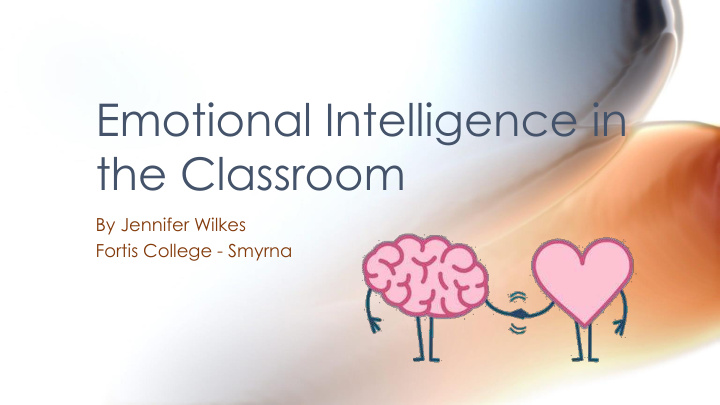



Emotional Intelligence in the Classroom By Jennifer Wilkes Fortis College - Smyrna
EQ in the Classroom • What is EQ? • Ideal Instructor • Why is EQ important? • EQ in the workplace • EQ skills • Emotions • Developing EQ • Applying EQ in the classroom • EQ activities
What is EQ? • Coined by John Mayer and Peter Salovey in 1990 • “An individual’s capacity to reason about emotions and to process emotional information to enhance cognitive process and regulate behavior” (Brackett & Katulak, 2006, pp. 2-3) • The ability to be self- aware and recognize one’s emotions and the emotions of others while managing one’s emotions
What is EQ?
Ideal Instructor Teaching & Emotional Learning Intelligence Methods Subject Expertise
Ideal Instructor
Why is EQ Important? Intrapersonal • Self-awareness • Independence Interpersonal • Active listening • Empathy Adaptability • Decision-making • Problem-solving Stress Management • Emotional responsibility • Impulse control
EQ in the Workplace
4 Skills of EQ Management of Emotion Understanding of Emotion Use of Emotion to Facilitate Thinking Perception of Emotion
8 Basic Emotions • Fear: that something needs to • Acceptance: to open our hearts change • Disgust: to reject what is • Anger: to fighting against unhealthy problems • Anticipation: to look forward and • Joy: to remind us of what is plan important • Surprise: to focus on new • Sadness: to connect us with those situations we love
Emotions
Developing EQ Competencies • Know Yourself • Emotional literacy • Pause • Choose Yourself • Encourage choices • Make connections • Apply Yourself • Encourage Goalsetting (Lifelines)
Applying EQ in the Classroom • Pay attention to students • Validate aspirations • Create classroom stories • Encourage reflection /introspection/journaling • Build a classroom community • Emphasize responsibility • Validate emotions • Encourage creativity • Celebrate strengths
Activity: I Am… • I am most happy when ________________________. Instructions • I feel embarrassed when ❖ Complete each statement ________________________. based on how you feel. • I think negative thoughts about myself when _________________________. ❖ Add your own feeling words. • I am defensive when • I am _____ _________________________. • I feel _____ • I feel confident when • I think ____ about ____ when _________________________.
Group Activity: High 5 Instructions 1. Tape a sheet of paper to the back of each person’s back (color preferred) 2. Use a pen to write at least one positive comment about that person’s strengths on the person’s sheet. 3. Remove the sheet and discuss the comments openly
References Brackett, M.A., & Katulak, N.A. (2006). Emotional intelligence in the classroom: Skill-based training for teachers and students. Yale. Retrieved from http://ei.yale.edu/wp- content/uploads/2013/12/pub101_BrackettKatulak2006Th eEIclassroom.pdf.
Recommend
More recommend